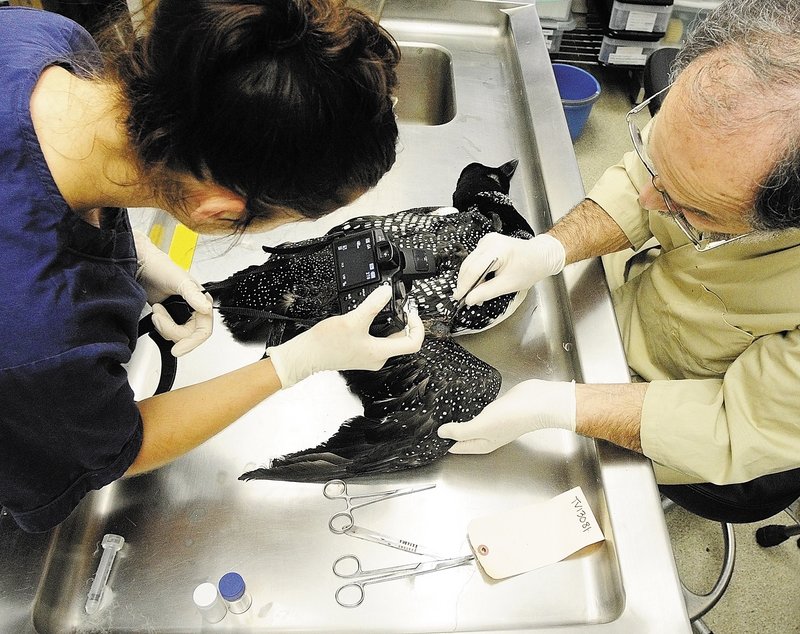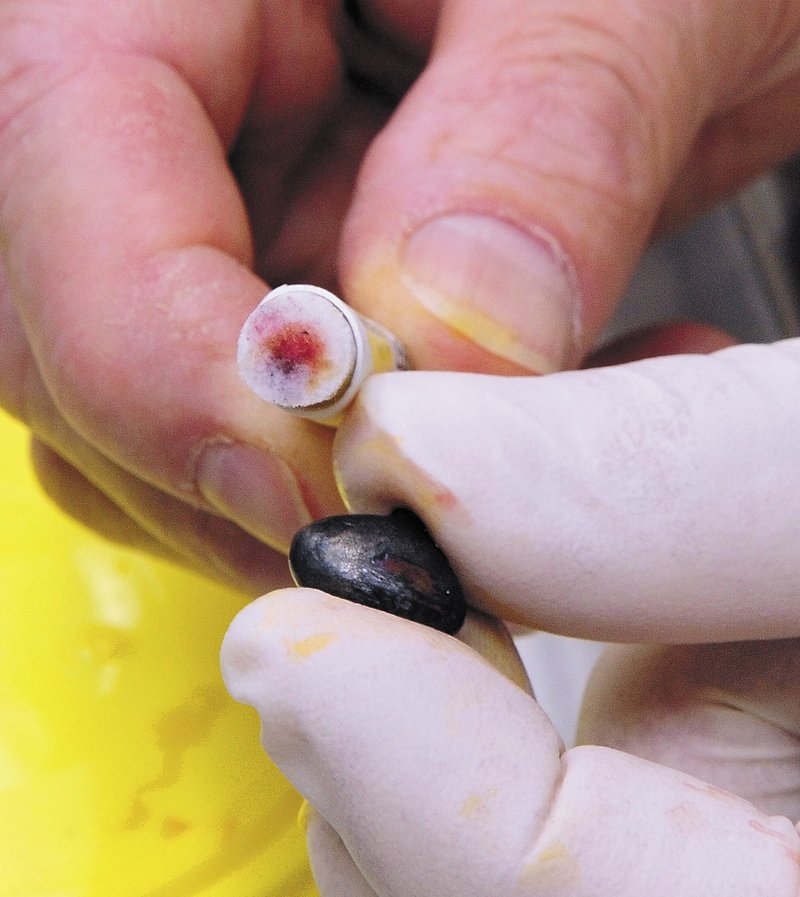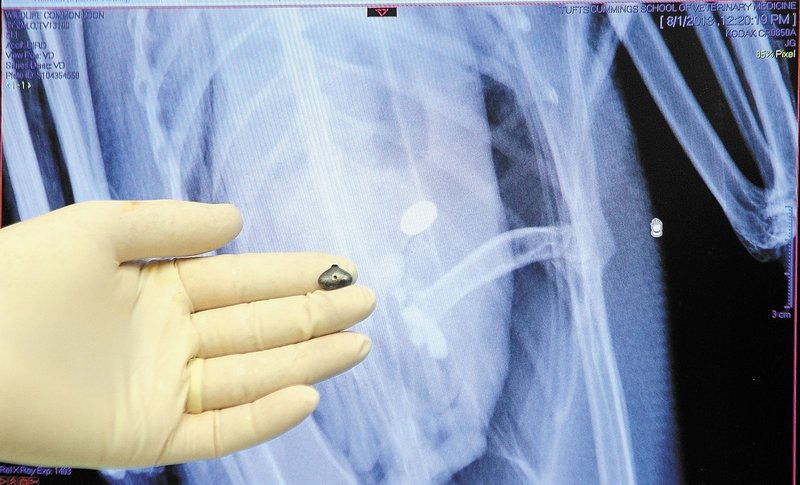NORTH GRAFTON, Mass. – A loon was beached on Cobbossee Lake in Winthrop, Maine, a maggot-filled wing wound keeping it from flying or resisting capture from a game warden.
The gash was too deep and the skin around it too decayed to save the agonized, emaciated bird. It was euthanized at an avian clinic in Freedom, Maine.
Enter Mark Pokras, whose job it is to figure out why the bird was disabled in the first place.
Since 1987, the Tufts University professor of wildlife health has done necropsies on approximately 2,000 loons, nearly 500 of them from Maine.
The small necropsy room in a corner of a clinic at the university’s veterinary medicine school, on a rural campus less than 10 miles east of Worcester, is a laboratory of the macabre.
One day in mid-August, rabbit, loon and turtle cadavers lay in a refrigerator awaiting examination, each of their deaths a mystery for Pokras, an animal medical examiner, to solve.
Maybe the wing wound means the loon was attacked by an eagle, Pokras wonders aloud. Loons are also known to fight, so maybe it’s from a pointed beak, normally used to spear fish.
Then again, those could just be good stories.
“But that’s what we do,” Pokras said. “We make up stories and then we try and test them.”
The necropsy is the test. And as the loons have piled up, a trend has emerged.
Though the Cobbossee bird wasn’t affected, Pokras has discovered that lead poisoning is the leading cause of premature death in Maine loons, whose haunting wails are a fixture of summer life, their images adorning license plates and trinkets at tourist shops.
He was a main voice behind a law passed earlier this year by the Maine Legislature that banned lead fishing sinkers and jigs, identified as the major culprit behind poisoning.
The law will fully ban sale and use of the lead fishing gear weighing one ounce or less or measuring 2½ inches or less by 2017.
But with a loon population that has boomed since it was first counted 30 years ago, Maine sportsmen are split on the ban. Conservationists, though, say the boom isn’t what it seems and loons are vulnerable.
UNDER THE KNIFE
In Pokras’ necropsy room, Julia Graham, a 2012 graduate of Mount Holyoke College in South Hadley, Mass., applying to veterinary schools and volunteering to assist the professor, made the first cut into the Cobbossee Lake loon.
The blade was drawn just under the skin. Small feathers flew. The loon’s subcutaneous fat was gone, suggesting a period of weakness and starvation before death.
After that, the sternum was removed, revealing the loon’s organs. There was still fat around the heart, the last store to be depleted before loons starve to death in the wild, Pokras said.
Graham cut open the bird’s trachea to check for signs of fungal infection, which can plague loons in the wild. There was no sign of that.
Next is a cut into the gizzard, the bird’s specialized stomach. If a lead sinker or jig were there, it would likely be seen in an initial X-ray of the bird and pulled out at this step.
But the Cobbossee bird’s gizzard was mostly normal, holding the pebbles loons dive down lake bottoms to swallow in order to help break down food in their digestive tract.
That’s where breeding adults almost always pick up lead from fishing gear that has fallen to lake bottoms, Pokras said. Before the necropsy on the Maine loon, he pulled a lead jig head out of another loon’s gizzard, that one from New Hampshire.
All of that bird’s fat was gone, but its muscles hadn’t begun to waste away. A blood test showed the loon was carrying more lead than Pokras could test for.
“This is a bird that didn’t starve to death. If it had starved to death, we’d see more muscle loss,” Pokras said. “I think the lead killed it before it had a chance to get any further.”
LEAD POISONING FROM FISHING GEAR
A 2013 report from the Maine Audubon Society, aggregating the results of 450 Pokras necropsies of Maine loons from 1987 to 2012, found that lead poisoning from fishing gear was the leading cause of death in adult loons, killing 97 out 352 adults examined.
Of those loons, 21 were poisoned to death by lead fishing gear in 11 lakes in Kennebec, Franklin and Somerset counties, including Cobbossee, water bodies in the Belgrade Lakes area and Rangeley Lake, the report says.
Cobbossee and Great Pond, in the Belgrade area, each had four poisoned loons in that time, the most in the state.
Lead, experts say, is a terrible way for a loon to die.
Pokras said the digestive tract contracts irregularly and painfully and birds become dopey and slow to react, making them vulnerable to predators or unrelated illness. They’ll often end up beached onshore, eyes half-closed and gasping for air before succumbing.
Poisoning in birds can be treated at clinics like Avian Haven, the bird rehabilitation center in Freedom where the Cobbossee loon was euthanized, according to Diane Winn, the clinic’s co-director.
She said two methods of treatment are usually used — chelation, where agents that bind to lead are given to the bird and excreted — and gastric lavage, or stomach pumping.
But once loons get to her, they’re usually too far gone. Winn said she usually can’t save them.
“By the time they’re sick enough to beach themselves and be captured, it’s usually too late,” she said. “It’s painful to watch and I’m sure it’s painful to experience.”
DOUBTING THE SCIENCE
However, Dave Barnes Sr., president of the Bass Federation of Maine and a fishing guide from China, doubts the science used to get the lead ban passed.
He said the loon death count isn’t high enough to necessitate the law, which he said would simply discourage fishing by upping the cost for fishing gear.
Testimony from Susan Gallo, who directs the annual Maine loon count for the Audubon Society, before a legislative committee earlier this year, included costs of lead, tungsten and metal jig heads. According to that testimony, 25 of the cheapest lead jigs cost $3.59, or 14 cents apiece. The cheapest alternative, made of tin and bismuth, cost 88 cents apiece.
Barnes also noted that the loon population is healthy. When the loon count started in 1983, it found 1,800 statewide. Last year, it found approximately 3,000.
“You take all these deaths in combination, what’s the sense to tax fishermen and anglers doing the sport they love?” Barnes said. “I’m a Vietnam veteran, I fought for this country, and I’ll tell you, I never thought I’d have to fight for my right to fish.”
But Gallo said lead poisoning is “one of the biggest of the little factors” affecting loons. “If you want to call them little.” Others include boat strikes, wakes from boats that upset nesting areas near shorelines, and predators.
In coming years, she said loons will likely see the impact of climate change as lakes warm and rainstorms get bigger, changing shorelines and nesting areas. She said while it’s difficult to stop boats from speeding, lead is one of the most easily avoidable threats posed to loons now.
“If we can eliminate any of those threats now, that’s the best thing to do to give them the best chance in the future,” Gallo said. “Lead is on its way out. It’s a known toxin. Nobody should be handling it; nobody should be using it.”
The Sportsman’s Alliance of Maine, a pro-fishing group, didn’t oppose the bill. Executive Director David Trahan said he has volunteered at Avian Haven and seen the effect of lead in birds firsthand.
“I don’t think any Maine citizen or sportsman wants birds to suffer inadvertently,” he said.
DEATH REMAINS A MYSTERY
Although Pokras is a renowned detective, even he can’t solve all the cases. After the two-hour necropsy, the Cobbossee Lake loon’s death was a mystery.
“My guess is that this is an older animal that’s been through the wars,” he said. “This bird’s been swimming around out there for days, at least, before it started going downhill.”
He could only assume the loon’s history: It was an ovulating female that couldn’t have flown or eaten much shortly before its death. It likely had chicks earlier in the summer, and they’re likely dead because their mother couldn’t care for them, Pokras said.
But, he concedes, “probably, we’ll never really know.”
That’s not uncommon: The Audubon Society report said in another 28 percent of Maine loon deaths Pokras investigates the cause of death is unknown, largely because of deteriorated carcass condition.
However, the biologists working with him say he’s providing them with information that is crucial to maintaining Maine’s loon population.
“It really identifies some of the risks that these birds are up against,” said Danielle D’Auria, a wildlife biologist with the Maine Department of Inland Fisheries and Wildlife.
Pokras has done it all since 1987 without any contract with the state or the Audubon Society. It’s an informal arrangement done on a shoestring budget at the university level and reported to the state and society, which also have limited money.
Sick or dying loons are often reported by members of the public, then picked up by game wardens or other officials.
Dead ones are sometimes stored by the state, and D’Auria, based in Bangor, said she often coordinates the dead loon exchanges with Pokras.
When Gallo visits her in-laws in Springfield, she’ll drop off however many carcasses the Audubon Society has collected from members of the public.
“Whenever I see Mark, it always involves dead loons,” she said.
Pokras said he didn’t expect to make a career of cutting open animals when he started in 1987.
But he’s driven by a commitment to improving public health, and he sees his work with lead poisoning in animals as pertinent to human health. Handling lead poisons people and putting it in the environment can’t help anyone, he said.
“We have to be thinking about the world we all live in,” Pokras said.
Michael Shepherd can be reached at 370-7652 or at:
mshepherd@mainetoday.com
Send questions/comments to the editors.





